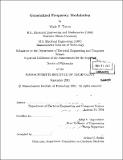| dc.contributor.advisor | Alan V. Oppenheim. | en_US |
| dc.contributor.author | Torres, Wade Patrick | en_US |
| dc.contributor.other | Massachusetts Institute of Technology. Dept. of Electrical Engineering and Computer Science. | en_US |
| dc.date.accessioned | 2005-08-23T22:26:31Z | |
| dc.date.available | 2005-08-23T22:26:31Z | |
| dc.date.copyright | 2001 | en_US |
| dc.date.issued | 2001 | en_US |
| dc.identifier.uri | http://hdl.handle.net/1721.1/8697 | |
| dc.description | Thesis (Ph. D.)--Massachusetts Institute of Technology, Dept. of Electrical Engineering and Computer Science, 2001. | en_US |
| dc.description | Includes bibliographical references (p. 127-128). | en_US |
| dc.description.abstract | In frequency modulation (FM) systems, a continuous-time information signal is modulated onto a sinusoidal carrier wave by using the information signal to modulate the frequency of the carrier wave. In this thesis, a more general type of modulation is developed, of which FM is a special case, that we refer to as rate modulation. A rate modulation system consists of a dynamical system whose rate of evolution is varied in proportion to an information signal. The rate-modulated carrier wave is a scalar function of the state variables of the modulator. The thesis is focused on three aspects of rate modulation and demodulation systems. First, explicit expressions are derived for the power density spectrum of the rate modulated carrier wave for sinusoidal modulation. Second, a systematic procedure is derived for constructing demodulators. This procedure requires that the dynamical system used in the modulator has a known exponentially convergent observer. Assuming such an observer is known, a systematic procedure for constructing demodulators is given that depends on the underlying dynamical system in a simple manner. Finally, the quasi-moment neglect closure technique is used to approximate the signal-to-noise ratio when the carrier wave is corrupted by additive white-noise. | en_US |
| dc.description.statementofresponsibility | by Wade P. Torres. | en_US |
| dc.format.extent | 128 p. | en_US |
| dc.format.extent | 6883347 bytes | |
| dc.format.extent | 6883098 bytes | |
| dc.format.mimetype | application/pdf | |
| dc.format.mimetype | application/pdf | |
| dc.language.iso | eng | en_US |
| dc.publisher | Massachusetts Institute of Technology | en_US |
| dc.rights | M.I.T. theses are protected by copyright. They may be viewed from this source for any purpose, but reproduction or distribution in any format is prohibited without written permission. See provided URL for inquiries about permission. | en_US |
| dc.rights.uri | http://dspace.mit.edu/handle/1721.1/7582 | |
| dc.subject | Electrical Engineering and Computer Science. | en_US |
| dc.title | Generalized frequency modulation | en_US |
| dc.title.alternative | Generalized FM | en_US |
| dc.type | Thesis | en_US |
| dc.description.degree | Ph.D. | en_US |
| dc.contributor.department | Massachusetts Institute of Technology. Department of Electrical Engineering and Computer Science | |
| dc.identifier.oclc | 49837478 | en_US |
